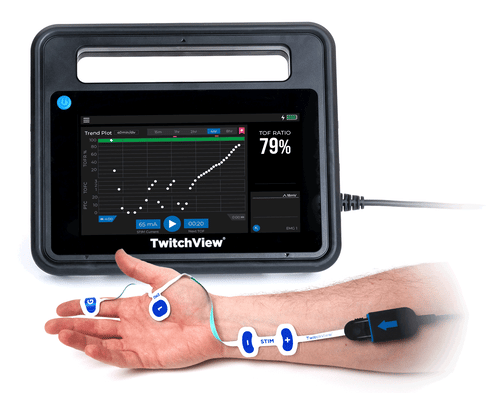Why Quantitative Neuromuscular Monitoring Should Be Standard Practice

The Persistent Challenge of Residual Paralysis
Many anesthesiologists still rely on clinical signs or qualitative twitch assessments to judge when a patient has fully recovered from muscle relaxants. Evidence shows this approach often misses residual neuromuscular blockade, even when patients appear strong enough to breathe or follow commands. Studies show up to 40% of patients may still have residual paralysis after surgery without quantitative monitoring, increasing their risk of airway complications and delayed recovery. Murphy (2010), Rodney (2024)
With modern electromyography (EMG) monitors like the TwitchView ® TOF Monitor, clinicians can confirm recovery with objective data, improving safety and reducing costly complications associated with residual paralysis. This is not about replacing drugs like sugammadex; it is about stewardship, ensuring patients receive the right dose, every time, guided by accurate monitoring.
The Limits of Clinical Signs and Qualitative Assessment
Historically, anesthesiologists have relied on physical signs or qualitative peripheral nerve stimulation to guide decisions about extubation and reversal dosing. However, studies have shown these methods are not reliable once the TOF ratio exceeds 0.4. At this level, fade is no longer visible or palpable, which means clinicians can easily misjudge recovery and extubate patients prematurely. Naguib (2018)
Clinical tests, such as head lift or grip strength, have also been shown to lack sensitivity. Even healthy volunteers with a TOF ratio of 0.7 experienced difficulty speaking, swallowing, or holding their head up. This highlights that traditional methods cannot ensure full neuromuscular recovery, and relying solely on them may leave patients vulnerable. Kopman (1997)
The Role of Quantitative Monitoring
Quantitative neuromuscular monitoring provides objective, numerical data on the depth of neuromuscular blockade. Instead of relying on subjective observation, clinicians can confirm when a patient has reached a safe TOF ratio of 0.9 or higher.
Among quantitative methods, electromyography (EMG) has emerged as a preferred technology. EMG measures muscle response directly through electrical signals, rather than relying on mechanical movement like acceleromyography (AMG). Studies show EMG aligns closely with mechanomyography (MMG), the gold standard, and offers greater accuracy and reliability in the operating room.
Modern devices, such as the TwitchView® TOF Monitor, have made EMG practical and easy to integrate into clinical workflows. Bowdle (2020, Comparative Study), Wedemyer (2023)
Sugammadex: A Powerful Tool That Still Requires Monitoring
The introduction of sugammadex was a turning point in anesthesia practice. This reversal agent can quickly and effectively reverse rocuronium or vecuronium blockade from almost any depth. However, sugammadex is not a substitute for monitoring.
Studies have found that even with sugammadex, residual paralysis occurs in up to 10 percent of cases when objective monitoring is not used. Variability in patient response means some individuals require higher or additional doses to achieve full recovery. Without monitoring, dosing becomes guesswork, and the risk of residual paralysis remains.
A stewardship approach combining quantitative monitoring and individualized rocuronium and sugammadex dosing has been shown to improve patient safety and reduce drug costs. In one study, quantitative monitoring allowed anesthesiologists to safely and conservatively reverse patients, reducing sugammadex usage and saving hospitals an average of $43 per patient.
Todd (2023), Kotake (2013); Thilen (2023)
Cost and Safety Benefits of Universal Monitoring
Hospitals often weigh the cost of new monitoring equipment against perceived benefits. However, multiple studies have shown that universal adoption of EMG-based monitoring pays for itself.
For example, a cost analysis found that implementing TwitchView monitoring across a single institution reduced postoperative pulmonary complications enough to generate $4.6 million in annual savings, far exceeding the technology investment.
Beyond cost savings, widespread monitoring improves:
- Patient safety: Reduced incidence of airway complications, hypoxemia, and delayed extubation.
- Compliance: Alignment with guidelines from the American Society of Anesthesiologists (ASA) and the European Society of Anaesthesiology and Intensive Care, both of which strongly recommend quantitative monitoring.
- Efficiency: Improved recovery room throughput and shorter hospital stays.
Edwards (2021), Thilen (2023), Fuchs-Buder (2022)
Changing Practice Culture
Despite clear evidence, adoption of quantitative neuromuscular monitoring remains inconsistent. Surveys of anesthesiologists reveal a disconnect between perceived and actual incidence of residual paralysis. Many clinicians believe the problem is rare, while data shows it affects a significant proportion of patients.
Implementing monitoring often requires cultural change. A quality improvement project at one academic medical center demonstrated that achieving near-universal EMG use took two years of sustained education, feedback, and training. The effort paid off, leading to a dramatic drop in inadequately reversed patients.
Education on correct electrode placement and device use is also key. One study found that a simple training program increased ideal electrode placement rates from 75 percent to over 95 percent and improved provider confidence in EMG data.
TwitchView: A Practical Solution
Not all quantitative monitors are created equal.
TwitchView was specifically designed to address the shortcomings of older systems:
- Integrated electrode arrays simplify setup and reduce variability.
- Validated accuracy: Studies confirm TwitchView’s close alignment with the MMG gold standard.
- Ease of use: One button start-up and automatic, continuous monitoring across all levels of block supports busy OR workflows.
By making EMG monitoring practical, TwitchView empowers anesthesiologists to confirm recovery with confidence and tailor reversal strategies to each patient.
A Safer Future with Objective Data
The evidence is clear: quantitative neuromuscular monitoring should no longer be optional, it should be the standard of care. Relying solely on clinical signs or qualitative twitch assessments puts patients at risk of residual paralysis and related complications.
The solution is simple: pair accurate EMG monitoring with thoughtful reversal strategies. This approach protects patients, reduces costs, and ensures compliance with best practice guidelines.
For hospitals and clinicians, adopting EMG-based tools like the TwitchView TOF Monitor represents a commitment to safer, smarter anesthesia. It eliminates clinical assumptions, empowers providers with data, and ultimately improves outcomes for every patient.
For more information, visit BlinkDC.com




